UK: Bedstraw Hawkmoth, F: Sphinx de la Garance, D: Labkrautschwärmer, RUS: Podmarennikovyi Brazhnik; Hyles Podmarenkova, S: Brunsprötad Skymningssvärmare, NL: Walstropijlstaart, CZ: Lišaj svízelový, H: galajszender, PL: Zmrocznik przytuliak, FIN: Matarakiitäjä, I: sfinge del galio, HR: broćikin ljiljak, DK: Snerresværmer, N: Vanlig mauresvermer, EST: Madara-vöötsuru.
Sphinx gallii von Rottemburg, 1775, Naturforscher, Halle 7: 107.Type locality: Germany.
(Taxonomic note. The study of Hundsdörfer et al. (2017) confirms the previously proposed synonymy of Hyles nepalensis (Daniel, 1960), Hyles gallii intermedia (Kirby, 1837) and Hyles gallii tibetanica (Eichler, 1971) with Hyles gallii, i.e. they are not separate species, or even subspecies.)
[Further details on this species, as well as photos of all stages, can be found on Lepiforum.]
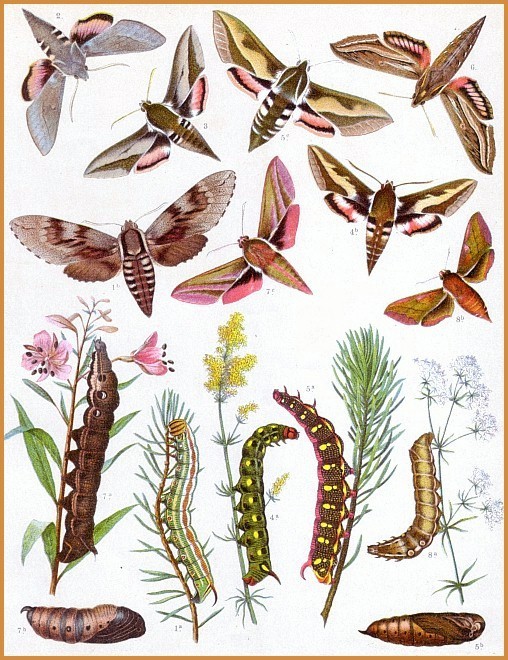
Holarctic; Palaearctic (both eastern and western subregions). Pleistocene refuge: Polycentric -- Holomediterranean, Caspian, Iranian, Turkestan, Mongolian and Manchurian refugia.
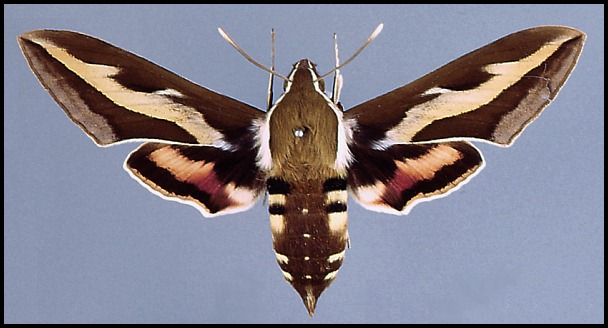
Wingspan: 65--85mm. The well-defined, pale oblique median stripe on the forewing distinguishes Hyles gallii from other similar members of the genus. There is very little variation: in f. grisea Tutt, the normally olive brown forewing areas are greyish and the red is absent from the hindwing discal band; in f. pallida Tutt, the forewing median stripe is white instead of yellowish. (For other forms see Eichler (1971).)
Populations from more arid regions tend to be paler in colour, those from cooler and wetter areas are darker. As in Hyles nicaea sheljuzkoi (Dublitzky, 1928) and Hyles hippophaes bienerti (Staudinger, 1874), many individuals from Kashmir and the Pamirs are much larger and paler than is normal.
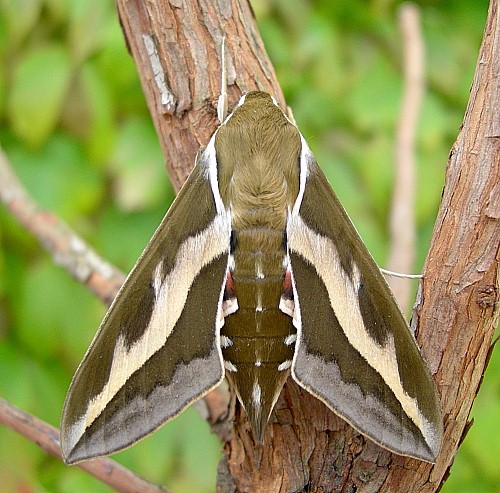
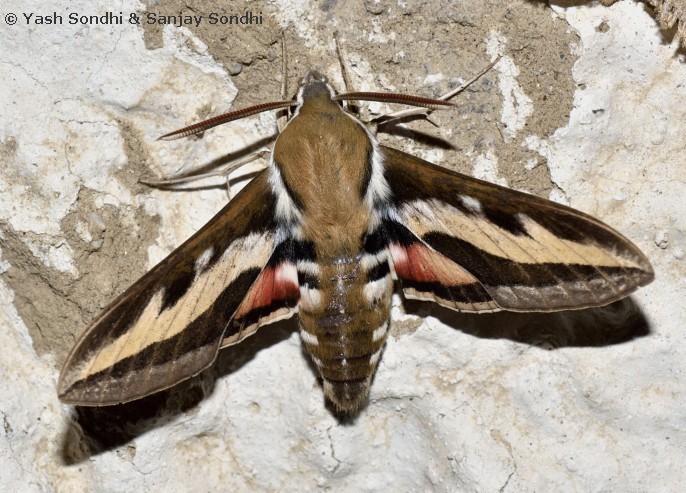
Frequents rough common-land, sand dunes, roadside verges, meadow edges and, especially, clear-felled areas in mountain forests where Epilobium and Galium are present; occurs up to 2000m in the Alps. In the warmer parts of Central Asia this species is strictly montane and only migrates down to lower elevations.
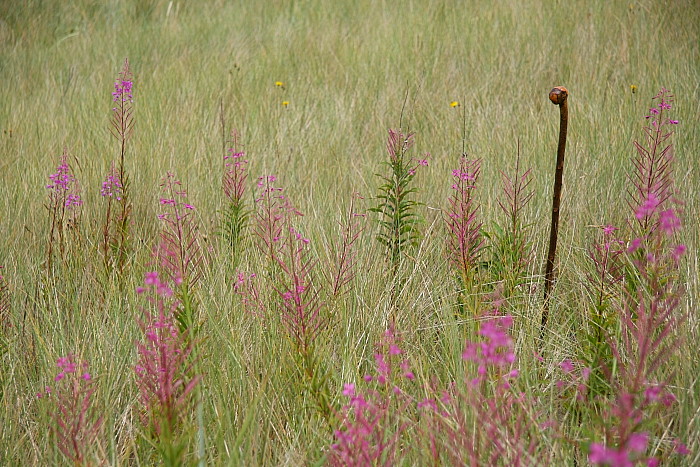
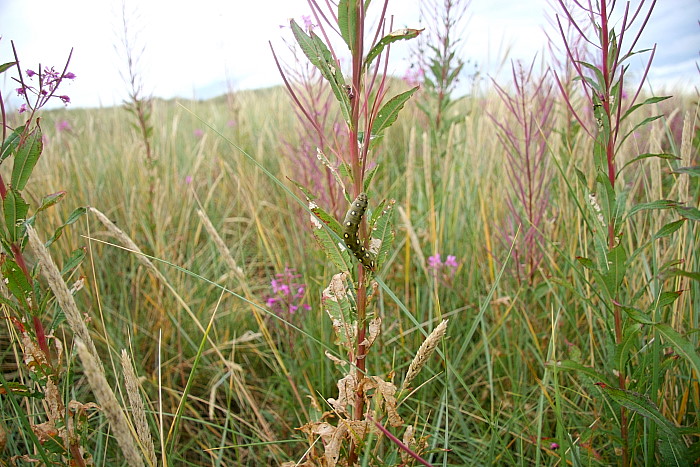
A strong flyer, it becomes active at dusk and again at dawn, when it searches for flowers from which it feeds avidly. Pairing rarely takes place before early morning and lasts approximately two hours. After extra feeding, females commence egg-laying one or two days later, continuing to do so for up to ten days. Both sexes are attracted to light.
If threatened and feeling at risk, resting adults will drop to the ground, raise their wings, press their antennae together frontad, arch their bodies, run and hop around, while flicking their forewings back and fourth to expose the red patch on the hindwings. Although not so extreme, this behaviour is also seen in many other sphingidae, especially Sphinx ligustri Linnaeus, 1758 and other members of the genus Hyles.
May/June and again in August/September, the latter generation only partial. In more northerly latitudes and at high altitudes, only one generation, occurring in July, is normal. In the southern Urals, from late May until early July, with a partial second generation in late August--early September (Nupponen & Fibiger, 2002).
OVUM: Small for the size of moth (1.1 x 1.0mm), almost spherical with a depression dorsally, glossy greenish blue. Deposited on the leaves of the hostplant or sometimes, as in the case of Galium, on the flowers, with up to four or five per plant.
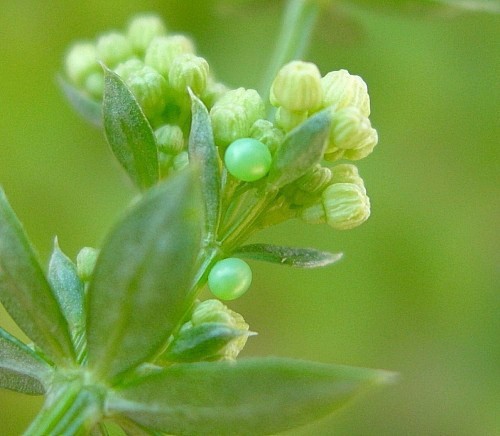
LARVA: Full-fed, 75--85mm. Polymorphic: one form mainly black.
Newly hatched, the 3--4mm-long larva is clear green with a number of yellow longitudinal lines. With growth, the green usually darkens to dark olive (or sometimes brown or black) and all lines except the dorso-lateral fade. This line gradually breaks up, to be replaced in the final instar by a row of startling, yellow or reddish eye-spots. The ventral surface in nearly all individuals is pinkish, and the head and horn red. In black larvae, both ventral and dorsal surfaces are of the same colour and the reduced eye-spots may be carmine red. All colour forms bear small yellow spots laterally and ventro-laterally, which may be extensive or barely visible.
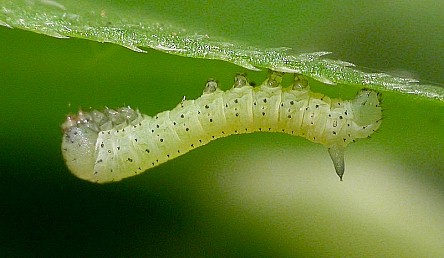
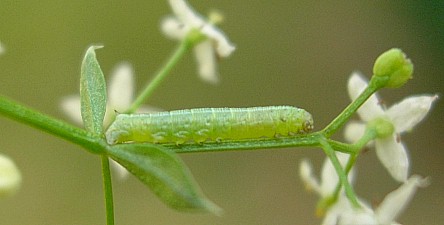
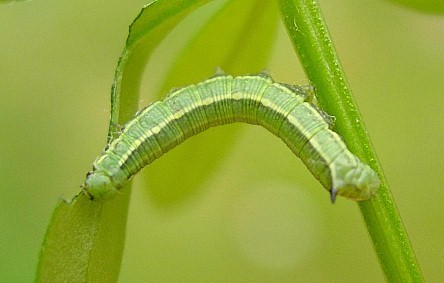
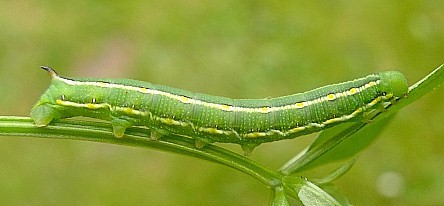
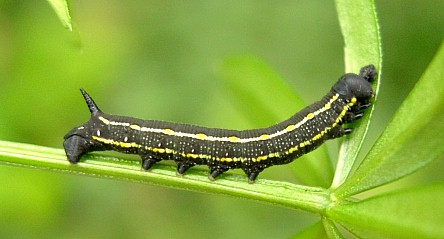
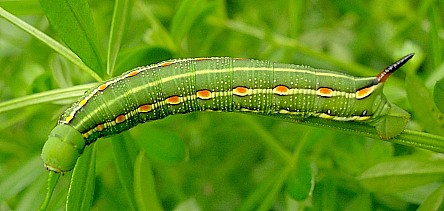
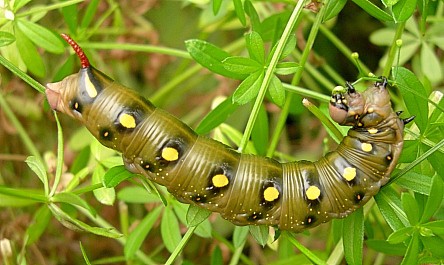
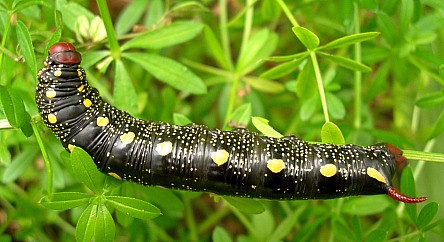
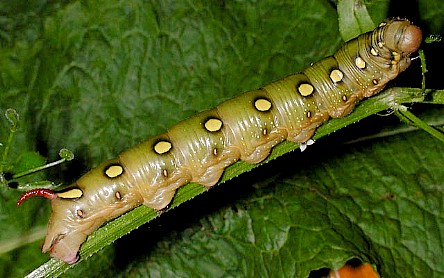
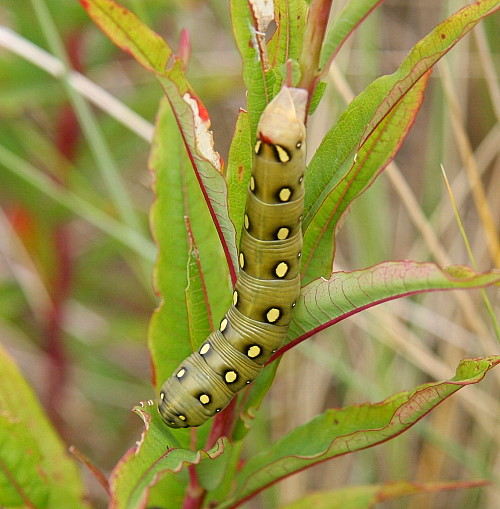
Initially, it feeds during the day and night, resting at intervals along the midrib under a leaf; when larger, larvae tend to retire low down on a plant by day, crawling up at dusk to feed. However, during wet weather fully-grown individuals may be seen in the daytime. As with Hyles nicaea (de Prunner, 1798), the number of larvae varies greatly from year to year, perhaps due to the weather or to the high rate of parasitism.
Occurs throughout most of its range during May, June and September; across its northern range and at high altitudes only from July to September.
Major Hostplants. Galium and Epilobium, especially Galium verum and Epilobium angustifolium.
Minor Hostplants. Betula, Vitis, Spiraea, Syringa, Geranium, Clarkia, Oenothera, Impatiens, Plantago, Asperula, Euphorbia, Crataegus and, in central Europe in particular, Fuchsia, Rubia and Salix. Rubia tinctoria is avidly eaten where the two overlap in range (Trimoulet, 1858). Reported by Roueast (1883) from Escallonia, but this is doubtful. However, this species will take an extraordinary range of hostplants in captivity.
Occasionally, species of Euphorbia may become major hostplants locally (Malyuta, 1934), as they have done so in Tibet and Nepal, e.g Euphorbia boissierii Baill. (Daniel, 1966), and Jammu & Kashmir/Ladakh, India, e.g. Euphorbia stracheyi Boiss. (Smetacek & Kitching, 2012).
PUPA: 40--45mm. Light brown with fine darker striations; encased in a loosely spun silk net amongst ground litter; very similar to that of Hyles euphorbiae (Linnaeus, 1758), although those produced by black larvae often have black wings and heavy black speckling on the abdomen. Those formed before mid-July usually hatch the same year, giving rise to a second generation. Overwinters as pupa.
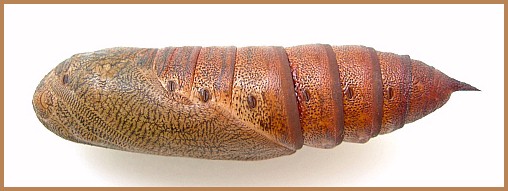
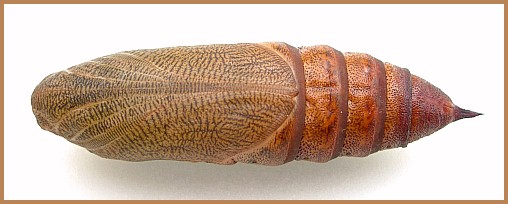
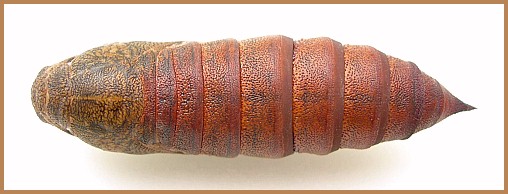
Ichneumonidae: Alcima orbitalis (Gravenhorst, 1829), Amblyjoppa proteus (Christ, 1791), Callajoppa cirrogaster (Schrank, 1781), Callajoppa exaltatoria (Panzer, 1804), Catadelphus arrogator (Fabricius, 1781), Habronyx heros (Wesmael, 1849), Metopius dentatus (Fabricius, 1779); Tachinidae: Blepharipa pratensis (Meigen, 1824), Compsilura concinnata (Meigen, 1824), Drino galii (Brauer & Bergenstamm, 1891), Drino vicina (Zetterstedt, 1849), Exorista fasciata (Fallén, 1820), Exorista larvarum (Linnaeus, 1758), Masicera pavoniae (Robineau-Desvoidy, 1830), Masicera sphingivora (Robineau-Desvoidy, 1830), Winthemia cruentata (Rondani, 1859).
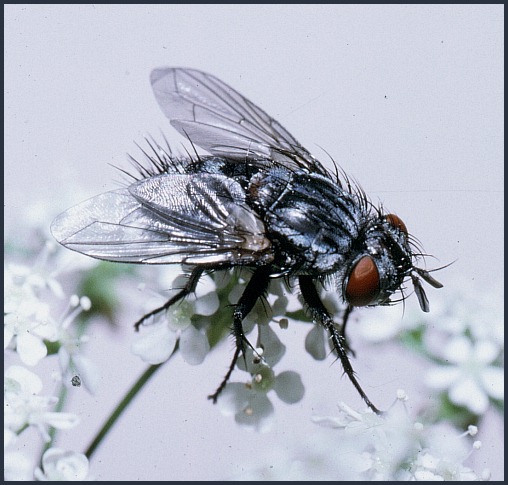
Resident throughout the damper regions of temperate Europe, from France (including Corsica (Derrick & Armand, 2021) to western Siberia (Knyazev, 2020) and the Altai Mountains of Russia (Izerskiy, 1999). Absent, apart as a migrant or temporary resident, from Britain (Newman, 1965), southern France and much of the Benelux countries (Selys-Longchamps, 1857; Meerman, 1987), the Iberian Peninsula south of the Pyrenees (A. Masó, pers. comm.), Italy south of the alpine region (P. Mazzei, pers. comm.; Sala & Bettini, 2005; Parenzan & Porcelli, 2006), Iceland (six individuals only), Norway (Aarvik, Berggren, Bakke, Haugen & Voith, 2006), northern Scandinavia, northern Russia and most of the Balkan Peninsula; however, it has been recorded beyond the arctic circle at Vorkuta in european Russia (Tatarinov, Sedykh & Dolgin, 2003) and at Noyabr'sk (63°10-15'N, 75°40'E) in western Siberia (Vladimir Dubatolov, pers. comm. 2010). It is resident in Croatia (Koren & aić, 2023), the cooler north of Bulgaria (Ganev, 1984; Hristova & Beshkov, 2016), Moldova (Tugulea & Tugulea, 2020), the Republic of North Macedonia (Krpač et al., 2019) and northern Turkey (Koçak & Kemal, 2018), the Republic of Georgia (Didmanidze, Petrov & Zolotuhin, 2013), Azerbaijan (Snegovaya & Petrov, 2021), Daghestan, Russia (Yakovlev et al., 2022), Tajikistan (Eichler, 1971; Danner, Eitschberger & Surholt, 1998), Kyrgyzstan (Danner, Eitschberger & Surholt, 1998; Korb, 2018; Toropov, Milko, Zhdanko & Evdoshenko, 2023), Uzbekistan (Urgut District, Samarkand region (Omonov, Rahimov, Askarova & Khomidova, 2023)), Afghanistan (Ebert, 1969), Pakistan/Kashmir (Bell & Scott, 1937; Rafi et al., 2014), India - Jammu & Kashmir/Ladakh (Smetacek & Kitching, 2012; Sidhu, Nair & Kubendran, 2018), India - Himachal Pradesh (Sidhu, Nair & Kubendran, 2018), eastern Kazakhstan (Danner, Eitschberger & Surholt, 1998) and Xinjiang Province, China (Pittaway & Kitching, 2000). Absent from North Africa.
Occasionally, colonies can establish themselves along the eastern coastal areas of England; these may persist for many years. One colony in Northumberland, England, has been present for more than 18 years (Vats Jaros, pers. comm. 2013).
Extra-limital range. From the Altai Mountains, south-west Mongolia (Yakovlev & Doroshkin, 2017), southern central Siberia (Izerskiy, 1999) and southern Yakutia/Sakha (Kaimuk et al., 2005) to northern and western China (including Xizang Province/Tibet), Nepal, Bhutan (Irungbam & Irungbam, 2019), Sakhalin Island, the Kurile Islands and northern Japan.
This species is also present in the USA (northeast as far south as Pennsylvania, the Great Lakes region, the upper Midwest, throughout the Rocky Mountains as far south as Utah and Colorado, and westward to Oregon and Washington State in the Pacific Northwest, as well as in Alaska) and Canada (from the eastern Maritime Provinces to northern Quebec and west to British Columbia and the Yukon Territory) (Tuttle, 2007).
None.
 Return to species list
Return to species list